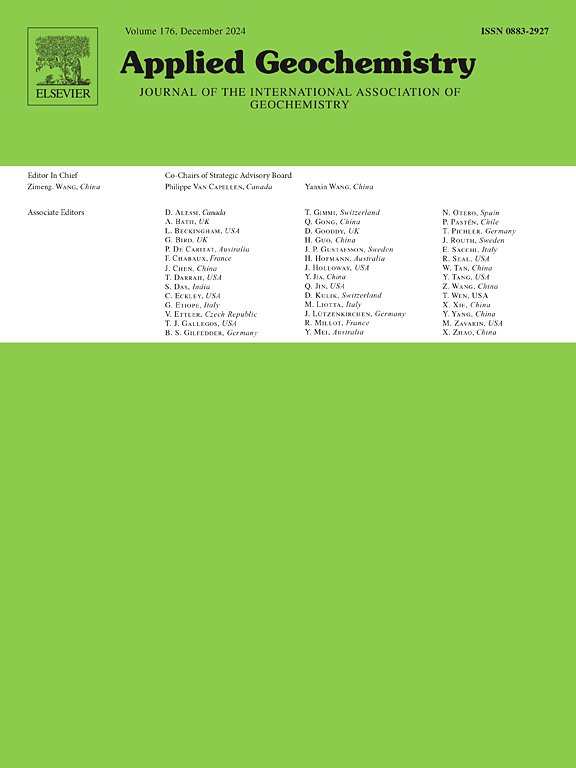Investigation on the performance and mechanism of Cr(VI) immobilization with improved amorphous iron polysulfide: Batch experiments and numerical simulation
IF 3.1
3区 地球科学
Q1 GEOCHEMISTRY & GEOPHYSICS
引用次数: 0
Abstract
Amorphous iron sulfides (FeSx), which are more powerful than crystalline FeSx in reduction, are commonly found on the surfaces of many sulfidated nanoscale zero-valent iron (nZVI). However, due to the interference of nZVI, the reduction performance of FeSx is still unknown. In this paper, we synthesized efficient amorphous iron polysulfide (AIPS) with FeSO4 and CaSx and checked its reduction ability using Cr(VI) as a model contaminant, and found that the reactivity and amorphous structure of AIPS were significantly affected by the titration rate of CaSx during synthesis. The removal of Cr(VI) by AIPS synthesized at a titration time of 120 min was 81.9 mg/g, which was 10.6 times higher than that of AIPS synthesized within 6 min (7.7 mg/g). The improved AIPS can be applicable for Cr(VI) removal via simultaneous adsorption, reduction and precipitation at wide pH range and in the coexistence of ionic and natural organic matter (NOM). Using a reactive transport model, it can be found that FeS and FeS2 in AIPS contribute 85.01 % and 14.99 % to the Cr(VI) reduction, respectively. FeSx (x > 2), also as a reaction by-product of the Cr(VI) reduction by FeS and FeS2, hinders the reduction of Cr(VI).

改进非晶多硫化铁固定化Cr(VI)的性能及机理研究:批量实验与数值模拟
非晶态硫化铁(FeSx)的还原能力比晶态FeSx强,常见于许多硫化纳米级零价铁(nZVI)的表面。然而,由于nZVI的干扰,FeSx的还原性能仍然未知。本文以FeSO4和CaSx为原料合成了高效非晶态铁多硫化物(AIPS),并以Cr(VI)为模型污染物考察了AIPS的还原能力,发现合成过程中CaSx的滴定速率对AIPS的反应性和非晶态结构有显著影响。120 min合成的AIPS对Cr(VI)的去除率为81.9 mg/g,是6 min合成AIPS (7.7 mg/g)的10.6倍。改进后的AIPS可以在较宽的pH范围和离子与天然有机物(NOM)共存的条件下同时吸附、还原和沉淀去除Cr(VI)。利用反应输运模型,可以发现AIPS中FeS和FeS2对Cr(VI)降低的贡献率分别为85.01%和14.99%。FeSx (x >;2),也是FeS和FeS2还原Cr(VI)的反应副产物,阻碍了Cr(VI)的还原。
本文章由计算机程序翻译,如有差异,请以英文原文为准。
求助全文
约1分钟内获得全文
求助全文
来源期刊

Applied Geochemistry
地学-地球化学与地球物理
CiteScore
6.10
自引率
8.80%
发文量
272
审稿时长
65 days
期刊介绍:
Applied Geochemistry is an international journal devoted to publication of original research papers, rapid research communications and selected review papers in geochemistry and urban geochemistry which have some practical application to an aspect of human endeavour, such as the preservation of the environment, health, waste disposal and the search for resources. Papers on applications of inorganic, organic and isotope geochemistry and geochemical processes are therefore welcome provided they meet the main criterion. Spatial and temporal monitoring case studies are only of interest to our international readership if they present new ideas of broad application.
Topics covered include: (1) Environmental geochemistry (including natural and anthropogenic aspects, and protection and remediation strategies); (2) Hydrogeochemistry (surface and groundwater); (3) Medical (urban) geochemistry; (4) The search for energy resources (in particular unconventional oil and gas or emerging metal resources); (5) Energy exploitation (in particular geothermal energy and CCS); (6) Upgrading of energy and mineral resources where there is a direct geochemical application; and (7) Waste disposal, including nuclear waste disposal.
 求助内容:
求助内容: 应助结果提醒方式:
应助结果提醒方式:


